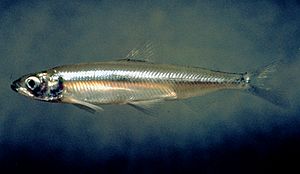Delta smelt facts for kids
Quick facts for kids Delta smelt |
|
|---|---|
 |
|
| Conservation status | |
| Scientific classification | |
| Genus: |
Hypomesus
|
| Species: |
transpacificus
|
The delta smelt (Hypomesus transpacificus) is a small, slender fish. It is about 5 to 7 centimeters (2 to 3 inches) long. This fish is a type of smelt.
It lives only in the upper Sacramento-San Joaquin Estuary in California. The delta smelt mostly lives where fresh water and salt water mix. But during spawning season, it swims upstream into fresh water. This usually happens from March to May.
The delta smelt is like an indicator species. This means it shows how healthy the Delta's ecosystem is. It lives for only about one year. This makes it very sensitive to changes in its home. People have tried to protect this fish. They have tried to limit water pumping in the estuary. But these efforts have not stopped the fish from almost disappearing in the wild.
Contents
About the Delta Smelt
The delta smelt is one of five types of fish in the Hypomesus group. This group is part of the larger smelt family. Scientists have studied these fish for many years. They want to understand how they are related.
Scientists use things like fin counts and genetic tests. They found that the delta smelt is closely related to another fish called H. pretiosus. Scientists think their ancestors might have lived across the Pacific Ocean. Over time, different groups of these fish became new species. This happened as their homes changed.
Where Delta Smelt Live
The delta smelt lives only in the Sacramento–San Joaquin River Delta in California. You can find them from Suisun Bay upstream through the delta. This area covers parts of Contra Costa, Sacramento, San Joaquin, and Solano Counties.
Delta smelt are pelagic fish. This means they live in the open water, not on the bottom. They can also live in water with different amounts of salt. They have been found in salty estuary waters.
In the past, delta smelt lived in a much larger area. This area changed with the seasons and water flow. Today, many parts of their old home are not good for them anymore. This is even though the water temperature and saltiness might be the same. Delta smelt disappeared from the southern part of their home in the late 1970s. This was when a lot more water was taken from the delta. Taking water out of the delta likely changed where the delta smelt lived. It also affected how many there were.
Life of a Delta Smelt
Delta smelt live for only about one year. They die after they spawn for the first time. Spawning happens in the spring. They lay their eggs in river channels and quiet backwater areas. These areas are upstream from where salt water and fresh water mix.
After the eggs hatch, the tiny delta smelt larvae float downstream. They go to the mixing zone, usually in Suisun Bay. The young delta smelt eat and grow in this area. Then, in late fall or early winter, they start swimming upstream to spawn.
Larger fish often eat delta smelt. These include striped bass and largemouth bass. These bigger fish are not native to the Sacramento-San Joaquin Delta. They were brought there by people.
Why Delta Smelt Are Endangered
Delta smelt used to be very common in the Sacramento-San Joaquin Estuary. But their numbers dropped a lot in the 1980s. In 1993, both the federal and state governments listed them as threatened. This means they were at risk of becoming endangered.
Their numbers kept getting lower. So, in 2010, California listed them as endangered. This means they are in danger of disappearing forever. Special areas were set aside as critical habitat for them in 1994.
The delta smelt is in danger because of human activities. These include cities growing, new species being introduced, and water being taken from the delta. Pollution and changes to their natural marsh homes also hurt them. In April 2015, only one delta smelt was found in a survey.
Even though they are almost gone in the wild, some delta smelt still exist. They are part of special breeding programs. One program is at UC Davis. Another is at a fish hatchery run by the U.S. Fish and Wildlife Service.
Protecting the Delta Smelt in Court
In 2005, a government agency said that big water projects were not harming the delta smelt. But a group called the Natural Resources Defense Council disagreed. They went to court. In 2007, a judge said the agency's decision was wrong. He ordered that the delta smelt needed protection.
In 2008, the agency made a new decision. This time, they said the water projects were harming the delta smelt. This meant the fish's survival was in danger. More groups then sued. The judge ordered weekly updates on water flow limits. He also brought in scientists to help him understand.
In 2014, a higher court looked at the case again. They said the agency's new decision was okay. They agreed that the water projects were putting the delta smelt in danger. The court said that endangered species must be saved, no matter the cost.
Some farmers do not like the delta smelt. They say that protecting the fish means less water for their farms. They claim that many acres of farmland have been left empty. They also say that thousands of jobs have been lost. However, a study in 2009 estimated that fewer jobs were lost due to smelt protection. It also said that a recent drought caused many other job losses.


